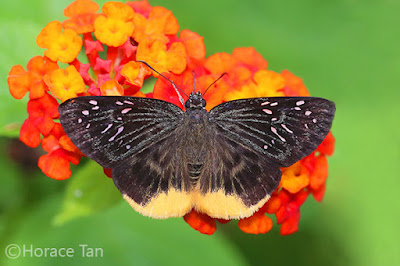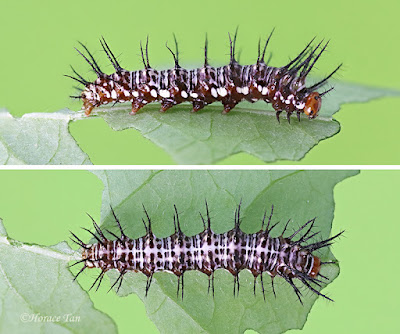The Yellow Flat (Mooreana trichoneura trichoneura)
A Yellow Flat sunbathing on a leaf with its wings spread open flat
And the final month of 2021 is here! It's the festive season, and the world needs to look ahead with more optimism. I am sure that we've had enough talk of COVID19 for the past 2 years, and it is something that everyone has grown tired of. Letting it continue to steal our precious time and control our lives will only make us more miserable. Despite a new variant and potentially more mutations, life has to go on. Measures are put in place, and risks are mitigated, and let us look forward to 2022 with greater optimism.
The month of December is a time for holidays, sharing time with our loved ones and a time for reflection and making resolutions for the new year ahead. In the northern hemisphere, the weather is generally colder and when birds fly south to warmer climes. But it is a time which gives meaning to a "White Christmas" and for us to revel in the beauty of Mother Nature's seasons.
A Yellow Flat feeding on pink Lantana flowers
Speaking of the weather, it is the monsoon season in Southeast Asia, and it has been particularly wet in neighbouring Malaysia. Inundated by floods over the past week, it is a grim reminder of climate change where extreme weather phenomenon affects many countries all around the world. The heavy rains continue unabated and it is likely that the floods will continue into the coming weeks. Strangely, the weather has been rather dry in Singapore with occasional thundery showers, but thus far, not enough to cause floods yet.
And over the past week or so, Singapore's news portals - both mainstream and social media have been filled with an uncommon "celebration" of sorts. News that a relatively unknown Singaporean badminton player - Loh Kean Yew, managed to upset higher ranked players, including World #1 Viktor Axelsen, on his way to win the BWF World Championship in Huelva, Spain. For the first time in its history, a Singaporean has won the BWF World Champion title - one that even neighbouring Malaysia (more of a badminton nation than Singapore) has never won before!
A Yellow Flat puddling on a concrete kerb
Our Butterfly of the Month for the final month of 2021 is the Yellow Flat (Mooreana trichoneura trichoneura). A newly discovered species for Singapore when it was spotted about nine years ago, the Yellow Flat is one of the species from the subfamily Pyrginae, often referred to as "Flats and Spread-Winged Skippers". It is described as a rare forest-dependent species in Malaysia, often flying in the lowlands.
Thus far, the species has only been spotted on the western side of Singapore, in the vicinity of the Nanyang Technological University (NTU). The Yellow Flat displays the typical behaviour of other species in the Pyrginae subfamily. It is often observed perched on the tops of leaves to sunbathe or feeding on flowers. But when alarmed, it flies quickly under a leaf and perches with its wings opened flat.
The upperside of the Yellow Flat's wings is dark brown with veins strongly dusted in white or pale yellow. The forewing bears a number of round and streaked hyaline spots in the distal half of the wing. The hindwing has a large yellow patch at the tornal area with yellow coloured cilia reaching up to vein 6. When viewed from the top, the abdomen is striped with pale yellow.
On the underside, the forewing is dark brown with the same set of spots as on the upperside. The hindwing is predominantly white from the dorsum to vein 6 with the white colouration diffusing into space 7 and beyond. Males of this species has a hair tuft on the mid- and hind tibiae.
The caterpillars have been successfully bred on a locally common plant, Mallotus paniculatus (Turn-In-the-Wind). This host plant is shared by several other local butterfly species. The caterpillar of the Yellow Flat creates a unique leaf shelter and makes it easy to spot when on the host plant. The adult butterfly, however, is not often seen in the field.
Wishing all our members and readers from around the world a Merry and Joyous Christmas and a Happy New Year!!
Text by Khew SK : Photos by Federick Ho, Huang CJ, Khew SK, Lim CA, Loh MY, Nelson Ong and Simon Sng



























































